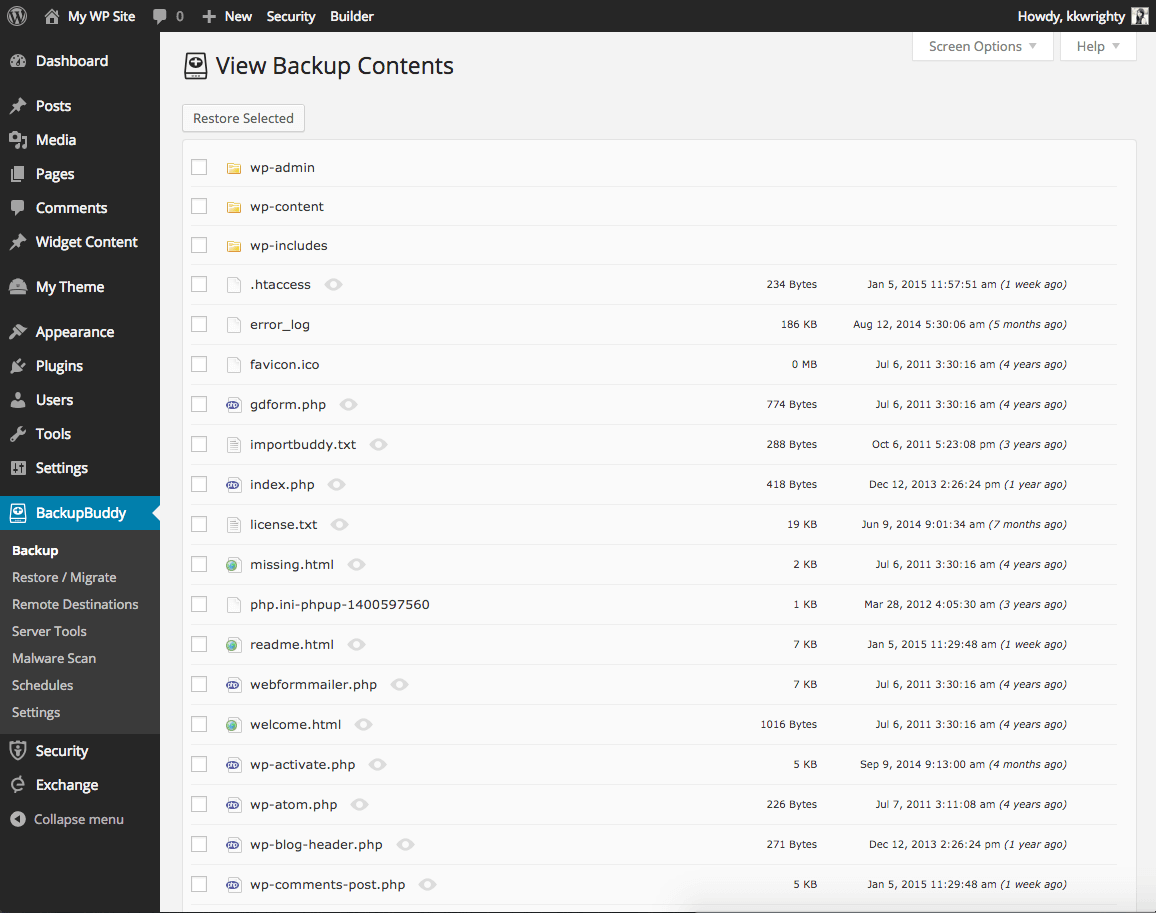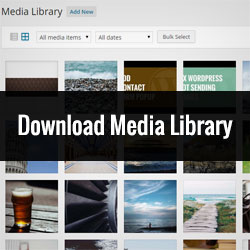- Download Images From Wordpress Media Library Hours
- Download Images From Wordpress Media Library App
- Download Images From Wordpress Media Library For Mac
- Wordpress Download Media Files
- Download Images From Wordpress Media Library Hours
- Wordpress Media Library Size
Short url:https://ewp.guide/go/editing-an-image
WordPress has a basic image editing tool that allows you to perform some simple manipulation with your uploaded images. You’re able to rotate and flip your images as well as scale them and crop them to different sizes.
When editing the file properties of an image (as opposed to other file types like documents or PDFs), click the Edit Image button that appears just below the image to show the image editing tools.
Download Images From Wordpress Media Library Hours
Import your images to the WordPress media library. Now, that you have the files uploaded to the server, you need to import them to the WordPress media library. But first, install the plugin called Add From Server, activate it and then, you can click the ”import files” option under the plugin name. Screenshot of the WordPress Media Library. Objects in the media library can be displayed as a grid, as in the previous image, or as a list. If you choose to display the items in list form, you have the option of selecting how many items are displayed in the list from Screen Options. Display options for Media Library elements.
If you click the Edit Image button whilst using the Grid View, the image editing tools will appear in the pop-up window.
By default if you use one of the WordPress importers, then it will try to import images. You can see the imported images by visiting Media » Library page in your WordPress admin area. If you see that all your images are already there, but the post URL is linking to the old source, then you don’t need this article. Feb 26, 2018 - This post is a collection of WordPress media library management plugins that help to categorize and organize. More info / Download. Classify all your images in a folder, and add a cover image to it for easy identification. Media → Library. Media consists of the images, video, recordings, and files that you upload and use in your blog. Media is typically uploaded and inserted into the content when writing a Post or writing a Page.Note that the Uploading Setting in the Settings Media Screen describes the location and structure of the upload directory (where your media files are stored). That’s all there is to do and it is that simple to download media library from WordPress using the FTP client or a plugin like DownML. You may also like to know how to automatically add title attribute to images in WordPress. So, do check it out. All I want is to download all images from the media library to my computer. I don't want to then use them in another site. Download images from media library to computer in BULK? If the WordPress blog in question is on wordpress.com, tough luck - you can't access the files via FTP, and the official support is only open to paying.
If you click the Edit Image button whilst using the List View, your page will look slightly different to the above Grid View. As well as the image editing tools, you’ll also see the properties of the file such as the file size and dimensions. You can also still update the Caption, Alternative Text and Description.
No matter what view you’re using, just above the image you’ll find the following image editing buttons:
| Crop – Click on the image and drag the selection box to size that you’d like the image cropped. Click the Crop button to crop the image to the new size |
| Rotate counter-clockwise – Rotate the image 90° counter-clockwise |
| Rotate clockwise – Rotate the image 90° clockwise |
| Flip vertically – Flip the image vertically |
| Flip horizontally – Flip the image horizontally |
| Undo – Undo the last change |
| Redo – Redo the last change |
To scale your image to a new size, simply enter the width or height dimensions in the appropriate field and click the Scale button. For best results, scaling should be done before performing any other operations like cropping, flipping or rotating the image. It’s important to note that images can only be scaled down, not up.
Download Images From Wordpress Media Library App
After entering one scale value, the other value will change automatically so as to keep the image in proportion. The original image dimensions are displayed just above the input fields, for your reference.

There are several ways to crop your image. The easiest is to simply click on the image and drag the selection box to the appropriate size. If you’d like your image cropped to a specific ratio, enter the values in the Aspect Ratio input fields (e.g. 1:1 (square), 4:3, 16:9 etc.). You can then hold down the shift key and drag one of the edges of your selection to enlarge or reduce the size, while keeping this aspect ratio locked. If there is already a selection made, specifying the aspect ratio will automatically change the selection to match it.
Whenever the selection box is adjusted, the dimensions are displayed in the Selection input fields. You can also manually enter the dimensions of the selection box (in pixels) by entering values into these two fields. Once your selection box is adjusted, simply click the Crop button just above the image to crop the image to this new size.
By selecting one of the options in the Thumbnail Settings panel, you have the option to apply your changes to All image sizes, just the Thumbnail image or All sizes except Thumbnail.
Click the Save button to save your changes.
Click the Update button to return to the main Media Library page.

If you’d like to revert back to your original image, click the Edit Image button again to return to the image editor. A new Restore Original Image link is displayed just below the Scale Image link. Click the Restore Original Image link and then click the Restore image button to discard your changes and restore your original image.
Do you want to import external images in WordPress? If you have recently moved your website from one platform to another, then there is a good chance that you may have external images embedded on your pages. In this article, we will explain how to properly import those external images in WordPress.
When and Why You Need to Import External Images?
External images are images embedded in your content that load from another website or URL different from your main site.
Most commonly, WordPress users come across external images issue after migrating their website from other platforms like Blogger, Weebly, Joomla, or WordPress.com.
By default if you use one of the WordPress importers, then it will try to import images. You can see the imported images by visiting Media » Library page in your WordPress admin area.
Download Images From Wordpress Media Library For Mac
If you see that all your images are already there, but the post URL is linking to the old source, then you don’t need this article. Instead, you need to update URLs using Velvet Blues Update URLs plugin.
However if you don’t see images imported to your WordPress media library, then continue reading and we will show you how to import those external images.
Video Tutorial
If you don’t want to watch the video tutorial, then you can continue reading the text version below:
Importing External Images in WordPress
First thing you need to do is to install and activate the Auto Upload Images plugin. For more details, see our step by step guide on how to install a WordPress plugin.
Upon activation, you need to visit Settings » Auto Upload Images page to review the plugin settings.
The default settings would work for most users, but you can change them as needed.
The plugin will import images to your default WordPress media uploads folder. You can change that by providing a different base URL. Other than that, it also allows you to set filename, image alt tag, image size, and exclude post types.
Once you are done, don’t forget to click on the Save Changes button to store your settings.
Next, you will need to update the posts or pages containing the external images. Since this is a manual process, it can be tedious if you have a lot of content.
Luckily, there’s a quick way to update all posts with external images. Simply go to Posts » All Posts page and then click on the Screen Options button at the top.
You need to increase the number to 999 in the ‘Number of items per page field’ field and click on the Apply button.
Wordpress Download Media Files
WordPress will reload the page, and this time it will show 999 posts at a time. Next, you need to select all your posts and then select Edit under the bulk actions menu.
After that you need to click the Apply button. WordPress will show you a quick edit box with all selected posts. You just need to click on the Update button, and WordPress will update all your posts.
Remember, don’t change any of the settings in the bulk edit settings that you see. You just need to click Update.
This process will trigger the plugin to check all selected posts and import external images as it finds them.
If you have more than 999 posts, then you will need to visit the next page to select remaining posts.
Download Images From Wordpress Media Library Hours
We hope this article helped you learn how to import external images in WordPress. You may also want to see our guide on how to fix common image issues in WordPress.
Wordpress Media Library Size
If you liked this article, then please subscribe to our YouTube Channel for WordPress video tutorials. You can also find us on Twitter and Facebook.